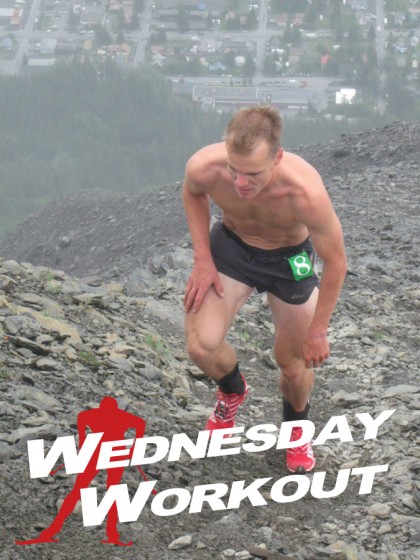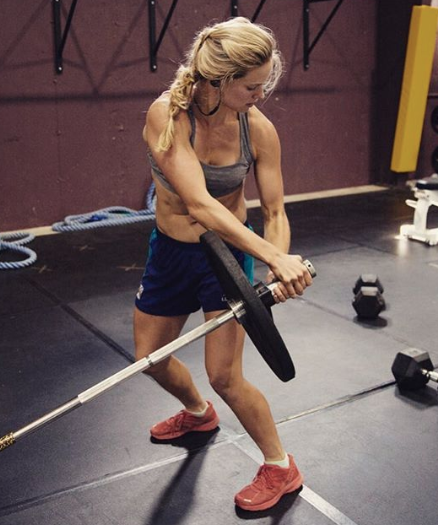
Editor’s Note: On July 4, Alaska Pacific University (APU) coach Eric Strabel shocked Alaska in officially clocking the fastest time up and down the 3,022-foot Mount Marathon. He finished 26 seconds faster than Olympic nordic skier Bill Spencer, who set the previous best 32 years ago. Strabel’s course record was no fluke; the 31-year-old APU university-team coach and elite-team assistant has been working at this for the last 12 months. His secret? Sustained hour-long Level 3 efforts. How does this relate to skiing? He thinks it’s how World Cup races are won.
“There are many promising young skiers talented with enough speed and power to be competitive at sprinting, but if they train assertively for longer efforts, they can eventually become the best in the world in distance races.” — Eric Strabel, in an email to FasterSkier
***
This is the approach that I used to design the workout that I used often months before I wanted to be at my best racing-fitness level.
The most important consideration, and criteria for designing this workout (and any workout), was that it had to suit a particular need, much like a mechanic has specialized tools to fit a certain job. The need was to correct a significant weakness, which was that my muscular strength would breakdown too soon at race pace.
In previous years’ races, I’d hit a certain point mid-ascent and my muscles would be broken down so much that I couldn’t drive my aerobic capacity at the same rate. My breathing would slow down and my heart rate would come down, but I certainly could not continue at the same speed. Sometimes I could dig down and reach into more fast-twitch fibers towards the very end of races and finish strong, but I had lost far too much over the middle portion for any closing speed to overcome.
(part of the Alaska Mountain Runners Grand Prix):
- 1st: Kal’s Knoya Ridge Run (5.6 k, 2900-ft elevation gain), May 23
- 2nd: Government Peak Climb (2.75 miles, 3500′ vertical), June 1
- 2nd: Robert Spurr Memorial Hill Climb (3 miles, 3300′ vertical), June 12
- 1st: Mount Marathon Race (3 miles, 3,022′ vertical), July 4
- Next up: Matanuska Peak Challenge (14 miles, 9100′ vertical) Aug. 3
You can call it endurance strength, muscle durability, slow-twitch fiber resistance to fatigue, or whatever, I knew it was a muscular endurance limitation and I just had to get it to not breakdown so quickly.
This is similar to cross country ski racing, and especially on FIS homologated courses with lots of sustained climbing. The ability to be strong and powerful for dozens of minutes — and not breakdown muscularly — is extremely important. It would not matter how high of a VO2max an athlete has if the muscles cannot continue to develop high tension for the entire length of the race.
So now that I knew what the limiting factor was, I had to design a challenge to target that specific weakness, get the most bang for the buck, and not compromise other things too much. The activity and technique was easy: as similar to the race as possible — Steep.
If I had a mountain ascent long enough with good footing conditions, I would use that but more often, I used a Nordic Track X7i Incline Trainer (just a steep treadmill) that went up to 40% grade. The intensity was not as obvious though. It had to be fast enough to move similarly to race type movements but easy enough that the work could be performed very aerobically so that I could push the muscles beyond the right endurance limit. So I settled on a range that is similar to what we skiers call Level 3, or between marathon and 15k race pace, or roughly 80-88% of max heart rate.
For the format of the workout, I could not think of a good enough reason to use intervals. I thought, if I’m working under that theoretical level called ‘threshold’, why should I need to pause the work to come back down, and especially if I wouldn’t be able to rest during the competition? Note: you could make a good argument to use short rest intervals to accomplish the same goal. And I would not worry if it takes 10 minutes to roller ski back down to the bottom of a 15 minute climb. And really, it does not need to be up a climb at all — simply over the terrain that you are wishing to improve on.
With those considerations, the workout that I found to challenge my body in the right way was as follows:
The workout: Sustained Level 3 efforts
- Warm up: To make a low L3 effort semi-comfortable, I found 20-30 minutes of warming up, progressing from very easy L1 up to L2, to be adequate.
- First 5-10 minutes: The beginning of the L3 effort is a conservative pace to allow a progressive effort.
- After 10-20 minutes, an assessment can be made from body’s feedback of what pace it can be ‘talked into’ being comfortable. This requires knowing your body well. One question that I could ask myself was, “how fast can you go easily?” I used a heart rate monitor and I became familiar enough with it to know that if I was in the low 80’s % of max heart rate at 10-15 minutes in, I could hold the same pace for about an hour without going over about 88% of max heart rate. I found that if I pushed close to or above 90%, it wasn’t long before I would need to stop.
- Judge a good finishing point. For me, it was about 60 minutes after starting the conservative L3 pace. I judged this to be a good point because that was just about 5-10 minutes longer than my comfort zone allowed, which was challenging but still ‘kept me wanting’ and so I’d come back and do it again 3-4 days later.
I could feel the benefits of this type of workout almost immediately. Most notably, the point in time that it became challenging to maintain the pace was delayed, and if I didn’t account for this by using a very slightly better pace by halfway, I’d get over an hour before reaching that point. And it was after about 10 of these workouts (~5 weeks) that I noticed that my pace for this 60 minute effort was right about what I had used for L4 intervals the previous year. So it was obvious that I was delaying that point of breaking down at the old race pace if I could breeze through it for an hour.
And when it came time to focus on higher intensities in the last couple of months before important races, I was pleasantly surprised that I had built a huge reserve to train at race intensity. I could perform more hard 6 minute L4 intervals than previously and I could perform the next L4 interval workout sooner. My body was strong enough that I could get a lot more out of the aerobic capacity training for cross-country skin. The sustained hour-long Level 3 efforts certainly was the right tool for the job.



